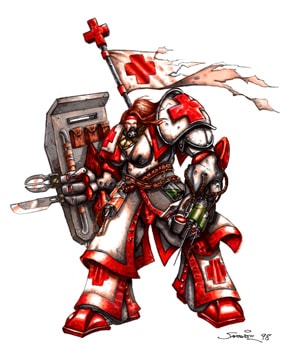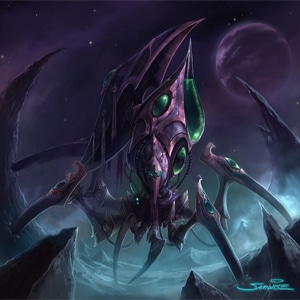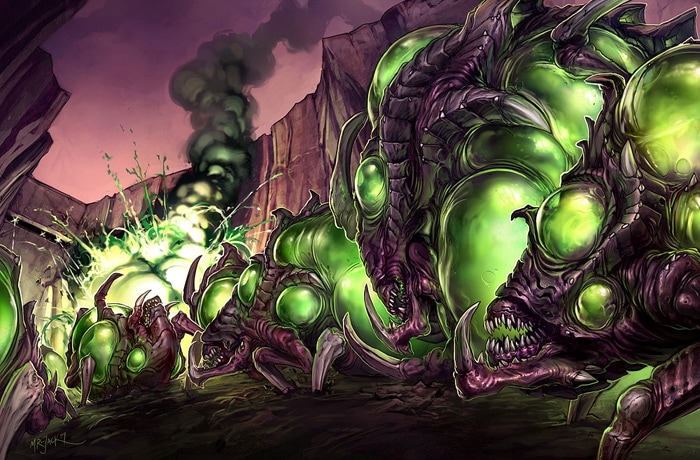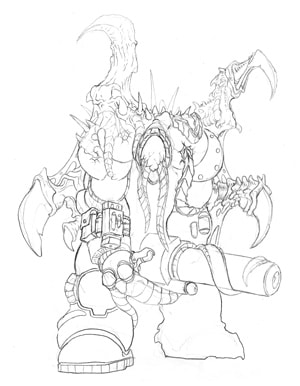Starcraft 2 news » Evolution Complete: Reimagining Classic StarCraft Units for StarCraft II
When a small team of 20 or so developers at Blizzard set out to conceptualize the original StarCraft, they didn’t face many limits beyond their own imagination—and a tight timeline. Really, their main goal was just to try their hand at making a cool science-fiction game.
“We’d done high fantasy twice already by then,” recalls Bob Fitch, lead engineer for the original StarCraft. “And we all really loved sci-fi. We’d watched Starship Troopers, we’d watched Aliens, we’d watched Star Trek. We wanted to leave the earth and go out into space.”
When the original StarCraft team started designing the three races at the game’s core—and the units that populate their armies—it was all about throwing anything and everything at the wall and seeing what stuck. The team behind StarCraft II, on the other hand, had a weighty legacy to contend with. They knew they had to create new units and buildings, as well as introduce new approaches to gameplay for each race, but they also had to stay mindful of what made StarCraft StarCraft.
The Battlecruiser, for example, is present in the original StarCraft for an understandable reason: space opera demands massive, lumbering battleships that equal the scale of their epic stories. The Battlecruiser was a relatively rare sight in competitive StarCraft or Brood War, however, so when Dustin Browder, StarCraft II’s game director, and David Kim, its lead multiplayer game designer, started working on the sequel in earnest—and with the explicit goal of designing it for intense, skill-based esports—they couldn’t help but wonder whether, or how, they could replace it.
It was a futile endeavor.
“It’s so iconic to the universe that we ultimately said, ‘It’s staying,’” Browder says. Making the unit smaller or faster would change its identity entirely—which would go against the whole point of keeping it in. “So it’s on us to make it work in the game.”
Creating StarCraft II’s units was a series of negotiations just like this—figuring out how many new things they could add, what they could cut out to keep each race’s unit count manageable, and what they had to change to make it all work together.
Medic and Dropship: The Merging Is Complete
The Medic, an iconic Terran unit introduced in StarCraft’s expansion Brood War, was initially meant to be part of the original game. Bob Fitch says that they simply didn’t have enough time to put her in.
 "In a lot of ways, Brood War was like the first official update, the first real balance patch for StarCraft,” Fitch says. The team started to design and build units to specifically serve as counters, or to simply shore up specific race’s weakness. Adding a healing unit made a lot of sense for the Terran, the race that leaned toward more defensive play styles.
"In a lot of ways, Brood War was like the first official update, the first real balance patch for StarCraft,” Fitch says. The team started to design and build units to specifically serve as counters, or to simply shore up specific race’s weakness. Adding a healing unit made a lot of sense for the Terran, the race that leaned toward more defensive play styles.
But for StarCraft II, Browder and Kim wanted to go somewhere else with the healing role.
“Medics were very powerful, but there wasn’t an enormous amount of counterplay for the unit,” Browder says. “Especially through the moderate skill levels, going in and picking off a single Medic was very difficult for some players.”
In the original StarCraft, the Medic’s utility often ended up encouraging passive play for the Terran, a race already known for its ability to quickly set up a solid defensive line anchored around Bunkers and Siege Tanks.
There was also the matter of trying to keep each race’s unit count from getting too big for its own good in StarCraft II, which Browder says would have just “gummed up the game.” So how do you keep the unit count reasonable, introduce an appropriate number of all-new units, and hold onto all the original ones people know and love?
“Eventually, we decided that if we do bring something back, we’ll have to cut something else,” Kim says. “So what can we cut?’”
Kim remembers another developer in the room saying that the Medic doesn’t do anything but heal Marines. Someone else followed up with, “Dropships are the same thing; all they do is transport units.”
It was a eureka moment for Kim. “I thought to myself, ‘you always use Dropships to drop and harass as Terran,’” he says. “Can we make that a bigger thing? And at the same time, when do you ever not use Medics when you’re using Marines and Dropships? Can we combine the two?”
Turning the Terran healer from a small infantry unit into a mid-sized ship helped opponents more effectively “read” them on the battlefield, which was Browder’s primary concern. Just as importantly, Kim says that the new unit gave Terran players a strong incentive to get out of their defensive shell and play more aggressively.
“Medivacs are balanced in a way that it’s advantageous to go for these frequent drops—the speed boosts they grant and the healing they provide, combined with the Marine DPS . . . it’s a powerful combination,” Kim says.
Dragoon and Stalker: Emerging from the Shadows
Terran units like Marines and Medics in power armor are no-brainers as grunt forces for the human race in a sci-fi epic. But for the enigmatic Protoss, the team creating the original StarCraft had to cast a wider net.
In the space opera the StarCraft team was constructing, the terran represented the familiar, while the zerg provided the monsters. “We needed a ‘grey alien’–type race,” Fitch says—a race driven by mysterious motives and possessed of advanced technology. “So we invented the Protoss.”
The faction’s primary infantry unit is the Zealot, and it’s essentially a non-wimpy grey alien wearing ornate power armor and wielding a wicked set of blades. But for units farther up the tech tree, it was basically anything goes.
“The Dragoon came out of a drawing that Sammy did one day,” Fitch says, referring to Samwise Didier, Blizzard veteran and StarCraft art director. “He drew this cool quadrupedal tank thing, and we thought: why don’t we make it shoot energy balls? And everyone was like, ‘Sure!’”
The Dragoon eventually became the backbone of many a Protoss player’s army in the original StarCraft. When it came time to decide on Protoss units for StarCraft II, however, Kim felt that the Dragoon would be too widely used. “It was too good at too many things,” he says.
The thematic spirit of the Dragoon was reincarnated in the Immortal, a heavy-duty artillery unit they’d first come up with as a way to help the Protoss counter Terran Siege Tanks; but there was also a spot earlier on in the Protoss tech tree for a more dynamic, less expensive unit than the Immortal.
 "We’d thought at one point, ‘Why don’t we make a Dark Dragoon?’” says Browder. They’d already made “dark” versions of other Protoss units, after all. So Didier came up with a concept of what a Dark Dragoon might look like.
"We’d thought at one point, ‘Why don’t we make a Dark Dragoon?’” says Browder. They’d already made “dark” versions of other Protoss units, after all. So Didier came up with a concept of what a Dark Dragoon might look like.
Browder recalls that as development went on, they were trying to find more ways to add precision “micro” mechanics to Protoss gameplay. The Dragoons, as Kim notes, were a sort of all-purpose menace that just walked up and fired at enemies. The Protoss, meanwhile, were the enlightened, super high-tech alien race—the one that would most make sense to have teleportation abilities. Expanding on this idea, they tried making the Dragoon faster, smaller, and more agile, and gave it a short-range blink ability. Thus StarCraft II’s Stalker was born.
Not only did this make Protoss gameplay more micro-intensive and dynamic, but in doing so, it gave the race a higher skill ceiling, which was a priority for the team.
“You can do some really crazy stuff with Stalkers, if you’re good enough,” Browder chuckles.
“We started to really see a difference between, say, a Bronze-level Protoss player and a Diamond one,” Kim says, “just based on how well they could maneuver their Stalkers.”
In the Genes: Infested Terrans Spawn Banelings
If the Protoss were the hyperadvanced aliens of StarCraft and Terran were its rough-and-tumble space cowboys, the Zerg were the savage monsters of the universe—the bugs and beasts that existed only to kill or spread their infestation. The zombie-like Infested Terran seemed like an obvious and great fit for the Zerg fantasy.

However, in the original StarCraft, the unit never found a place in the Zerg’s multiplayer arsenal. This might be due to its origins.
“We made the Infested Terran for a specific part of the campaign,” Fitch says, “and we weren’t going to leave something out of the multiplayer even if we hadn’t designed it specifically for multiplayer.”
The problem was that it was simply too hard to justify the substantial investment required to start producing them in the first place.
“You need to have a Queen, you need to have enough energy saved up, you need to be playing against the Terran, you have to hurt the enemy Command Center a certain amount but not destroy it, and then you have to spend money to actually build the Infested Terran,” Kim says. “And you do all of that to get a unit that, if it blows up before it reaches the enemy, it just deals zero damage, so you’ve wasted all this time and effort.”
That said, the team really liked the idea of an explosive suicide unit, but it had to deal more area damage and be easier to produce in the early game. “We eventually landed at a small bug that blows up, spreads goo onto everyone in its blast range, and infects those people, too,” says Browder. And that’s how we got the Baneling. To hear Browder tell it, the team “struggled for years” to get those little rolling balls of doom right.
 Banelings were designed to punish opponents foolish or careless enough to leave their forces clustered in large bunches—prime targets to receive the most damage from a bunch of exploding bugs. The developers expected players to struggle with spacing out their units against Banelings.
Banelings were designed to punish opponents foolish or careless enough to leave their forces clustered in large bunches—prime targets to receive the most damage from a bunch of exploding bugs. The developers expected players to struggle with spacing out their units against Banelings.
Then came the pro player MarineKing, renowned for—as his name suggests—his strong micro game with Terran units like Marines. “He wasn’t necessarily known for having the most innovative strategies in every game,” Kim said, “But because of his micro, he stood out.”
MarineKing quickly began to make a name for himself with his superhuman anti-Baneling tactics. He’d split his forces in a seemingly impossible number of directions, baiting his opponent to overextend their Banelings and ultimately waste much of their explosive potential. His technique became known as the “Marine Split,” and it took off as his fans tried to recreate it in their own games. “We didn’t intend for this to happen,” Kim said of MarineKing’s innovation. “But when it did happen, we were like, ‘How awesome is that?’”
As the Marine Split became more popular and Terran players got better at it, Kim expected that the balance team would ultimately have to continue buffing the Banelings. But something else happened: the Zerg players got better, too. The best of them found new ways to spread the Zerg creep farther and farther out on the map so they could give their Banelings an extra speed boost, even when they were using the explosive grubs for offensive maneuvers miles away from their central base.
“Suddenly we saw this whole new positional element come into Terran vs. Zerg games,” Kim recalled. “Both sides ended up stepping it up, and it made things really exciting.”
Looking back at the game and where it’s come 13 years after they first started working on it, Kim, Browder, and Fitch all muse about how things could have ended up differently, had they decided to take the game in a completely different direction.
“Some people simply wanted Brood War II,” Browder says. Others were upset that their favorite unit had been dropped. Some Protoss players really missed the Dragoon. But Kim and Browder didn’t see a way they could keep both the original Dragoon and the Stalker in the game without ultimately spoiling things for both units.
“You don’t want a ‘Marine 1’ and ‘Marine 2’ scenario,” Browder said, “That would just be a waste, because you’d just end up picking the ‘best’ one. That was our mentality, at least. I guess I could imagine a world where StarCraft II ended up with 100 units per race, but that wasn’t in line with our values when we started the game in 2005.”
“You could go back and say, 'What if we started from scratch?'” Browder concludes. “And, yeah, what if? I have no idea. That would change the whole paradigm of how we made the game.”















 Update comments
Update comments